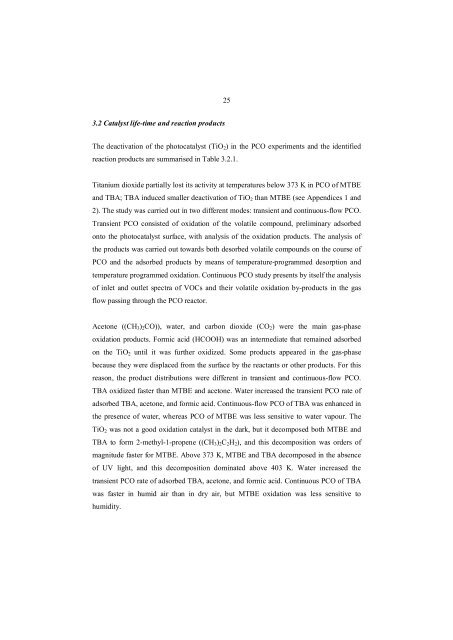gas-phase photocatalytic oxidation of volatile organic ... - Doria
gas-phase photocatalytic oxidation of volatile organic ... - Doria
gas-phase photocatalytic oxidation of volatile organic ... - Doria
You also want an ePaper? Increase the reach of your titles
YUMPU automatically turns print PDFs into web optimized ePapers that Google loves.
3.2 Catalyst life-time and reaction products<br />
25<br />
The deactivation <strong>of</strong> the photocatalyst (TiO2) in the PCO experiments and the identified<br />
reaction products are summarised in Table 3.2.1.<br />
Titanium dioxide partially lost its activity at temperatures below 373 K in PCO <strong>of</strong> MTBE<br />
and TBA; TBA induced smaller deactivation <strong>of</strong> TiO2 than MTBE (see Appendices 1 and<br />
2). The study was carried out in two different modes: transient and continuous-flow PCO.<br />
Transient PCO consisted <strong>of</strong> <strong>oxidation</strong> <strong>of</strong> the <strong>volatile</strong> compound, preliminary adsorbed<br />
onto the photocatalyst surface, with analysis <strong>of</strong> the <strong>oxidation</strong> products. The analysis <strong>of</strong><br />
the products was carried out towards both desorbed <strong>volatile</strong> compounds on the course <strong>of</strong><br />
PCO and the adsorbed products by means <strong>of</strong> temperature-programmed desorption and<br />
temperature programmed <strong>oxidation</strong>. Continuous PCO study presents by itself the analysis<br />
<strong>of</strong> inlet and outlet spectra <strong>of</strong> VOCs and their <strong>volatile</strong> <strong>oxidation</strong> by-products in the <strong>gas</strong><br />
flow passing through the PCO reactor.<br />
Acetone ((CH3)2CO)), water, and carbon dioxide (CO2) were the main <strong>gas</strong>-<strong>phase</strong><br />
<strong>oxidation</strong> products. Formic acid (HCOOH) was an intermediate that remained adsorbed<br />
on the TiO2 until it was further oxidized. Some products appeared in the <strong>gas</strong>-<strong>phase</strong><br />
because they were displaced from the surface by the reactants or other products. For this<br />
reason, the product distributions were different in transient and continuous-flow PCO.<br />
TBA oxidized faster than MTBE and acetone. Water increased the transient PCO rate <strong>of</strong><br />
adsorbed TBA, acetone, and formic acid. Continuous-flow PCO <strong>of</strong> TBA was enhanced in<br />
the presence <strong>of</strong> water, whereas PCO <strong>of</strong> MTBE was less sensitive to water vapour. The<br />
TiO2 was not a good <strong>oxidation</strong> catalyst in the dark, but it decomposed both MTBE and<br />
TBA to form 2-methyl-1-propene ((CH3)2C2H2), and this decomposition was orders <strong>of</strong><br />
magnitude faster for MTBE. Above 373 K, MTBE and TBA decomposed in the absence<br />
<strong>of</strong> UV light, and this decomposition dominated above 403 K. Water increased the<br />
transient PCO rate <strong>of</strong> adsorbed TBA, acetone, and formic acid. Continuous PCO <strong>of</strong> TBA<br />
was faster in humid air than in dry air, but MTBE <strong>oxidation</strong> was less sensitive to<br />
humidity.

















